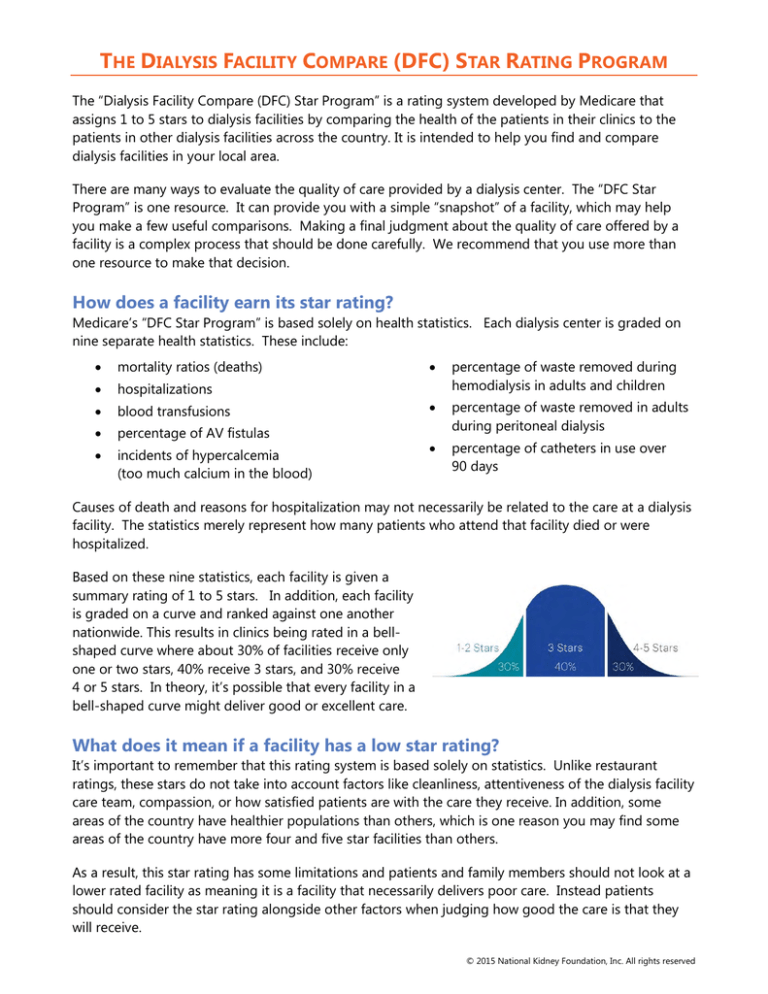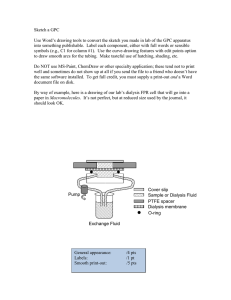How does a facility earn its star rating? What does it mean if a facility
advertisement

THE DIALYSIS FACILITY COMPARE (DFC) STAR RATING PROGRAM The “Dialysis Facility Compare (DFC) Star Program” is a rating system developed by Medicare that assigns 1 to 5 stars to dialysis facilities by comparing the health of the patients in their clinics to the patients in other dialysis facilities across the country. It is intended to help you find and compare dialysis facilities in your local area. There are many ways to evaluate the quality of care provided by a dialysis center. The “DFC Star Program” is one resource. It can provide you with a simple “snapshot” of a facility, which may help you make a few useful comparisons. Making a final judgment about the quality of care offered by a facility is a complex process that should be done carefully. We recommend that you use more than one resource to make that decision. How does a facility earn its star rating? Medicare’s “DFC Star Program” is based solely on health statistics. Each dialysis center is graded on nine separate health statistics. These include: mortality ratios (deaths) hospitalizations blood transfusions percentage of AV fistulas incidents of hypercalcemia (too much calcium in the blood) percentage of waste removed during hemodialysis in adults and children percentage of waste removed in adults during peritoneal dialysis percentage of catheters in use over 90 days Causes of death and reasons for hospitalization may not necessarily be related to the care at a dialysis facility. The statistics merely represent how many patients who attend that facility died or were hospitalized. Based on these nine statistics, each facility is given a summary rating of 1 to 5 stars. In addition, each facility is graded on a curve and ranked against one another nationwide. This results in clinics being rated in a bellshaped curve where about 30% of facilities receive only one or two stars, 40% receive 3 stars, and 30% receive 4 or 5 stars. In theory, it’s possible that every facility in a bell-shaped curve might deliver good or excellent care. What does it mean if a facility has a low star rating? It’s important to remember that this rating system is based solely on statistics. Unlike restaurant ratings, these stars do not take into account factors like cleanliness, attentiveness of the dialysis facility care team, compassion, or how satisfied patients are with the care they receive. In addition, some areas of the country have healthier populations than others, which is one reason you may find some areas of the country have more four and five star facilities than others. As a result, this star rating has some limitations and patients and family members should not look at a lower rated facility as meaning it is a facility that necessarily delivers poor care. Instead patients should consider the star rating alongside other factors when judging how good the care is that they will receive. © 2015 National Kidney Foundation, Inc. All rights reserved What other factors are important in judging the quality of care? If you are a new patient or a patient looking to temporarily receive dialysis in a new location, you can: Call or visit the dialysis facility. If you can’t go in person, send a friend or family member. Ask any questions you may have and decide if you were given easy to understand answers and how helpful the staff was to you. If possible, talk to multiple members of the dialysis care team including the dietitian, social worker, technicians, and nurses. Ask how well the facility performs on the Medicare Quality Incentive Program (QIP) score. This is a program that is administered by Medicare to help promote high-quality services in outpatient dialysis facilities by linking a portion of payment directly to facilities’ performance on quality of care measures. These types of programs are known as “pay-for-performance” or “value-based purchasing” (VBP) programs. If possible, talk to other patients in the facility. Ask if they are satisfied with the care they receive and whether the staff is knowledgeable and attentive to their needs. If you are currently receiving care in the facility, you should remember that you are the best judge of your own care. Some things you might want to consider are: How well does the dialysis facility staff listen to you and address your needs? How well do you feel during and after dialysis? Do you receive clear and understandable advice from the staff in the dialysis facility, such as, the dietitian, nurse, and social worker about what my role is in improving my own health? Is the facility adequately staffed with experienced, trained professionals? Is the staff compassionate? Attentive? Respectful? How would you rate the overall cleanliness of the facility? Does the facility offer a time and day for treatment that meets your needs? Is the schedule flexible? How do I find the five star rating system from Medicare? The “Dialysis Facility Compare (DFC) Star Program” can be accessed at www.medicare.gov/dialysisfacilitycompare. It is a service of the Centers for Medicare & Medicaid Services (CMS), an agency of the U.S. Department of Health and Human Services (DHHS). How can I learn more? If you have questions or concerns about the quality of care in a particular facility, you should contact the ESRD Network in the region where the facility is located. You can find the ESRD Network by visiting www.esrdnetworks.org. Learn more about your rights and responsibilities as a dialysis patient: www.kidney.org/sites/default/files/docs/dialysisbillrights.pdf. © 2015 National Kidney Foundation, Inc. All rights reserved


